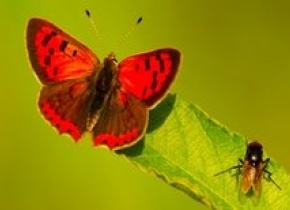

在城市里,尽管有一些移动性很强的物种通过生长来应对城市化,大多数无脊椎动物的平均体型都变小了。
撰文\播音:贾森·G·戈德曼(Jason G. Goldman)
翻译:邱燕宁
审校:张清越
Most critters seem better able to survive big cities if they’re smaller than usual. But a few others are better adapted to urban areas if they’re larger. That's the result of a study of more than 700 types of invertebrates from across 10 different taxonomic groups living in a variety of habitats in northern Belgium.
大多数的比正常体型小一些的小型动物似乎更适应在大城市生活。但是也有的种类里体型大一些的那些更适应城市环境。这是对生活在比利时北部不同栖息地的10个不同分类群的700多种无脊椎动物的研究结果。
European ecologists were interested in understanding how animals adapt to urbanization. So they set up a variety of traps in both urban and rural areas, and assessed the body size of more than 95,000 individual critters.
欧洲生态学家对动物如何适应城市化很感兴趣。因此,他们在城市和农村地区设置了各种陷阱,并评估了95000多只小型动物的体型。
They measured butterflies, beetles, weevils, ground spiders, web-building spiders, moths and grasshoppers. They also tested a handful of more obscure invertebrates, like a group of microscopic shrimplike critters called ostracods, and a group of aquatic crustaceans known as water fleas.
他们测量了蝴蝶、甲虫、象鼻虫、地面蜘蛛、织网蜘蛛、飞蛾和蚱蜢。他们还测试了一些更不为人知的无脊椎动物,比如一组被称为介脚类的微小虾类动物,以及一组被称为水蚤的水生甲壳类动物。
On average, urban communities contained smaller individuals than rural ones. It's not that cities are causing animals to evolve smaller bodies, at least not necessarily. What this study found is that animals that are already smaller seem better suited to city living. The researchers think that has to do with what’s called the urban heat island effect. Animals expend more energy going about their daily lives in warmer areas, and cities tend to be warmer than more natural areas. Smaller body sizes can compensate for that heat effect.
平均而言,城市群落的个体比农村小。并不是城市让动物进化出更小的身体,至少这不是必然的。这项研究发现,体型较小的动物似乎更适应城市生活。研究人员认为这与所谓的城市热岛效应有关。动物在温暖地区的日常生活中消耗的能量更多,城市往往比自然环境更温暖。较小的体型可以弥补热量的影响。
But some groups of city dwellers were actually bigger than were their countryside counterparts.
但是一些类群里城市个体实际上比农村个体要大。
"For three of our groups, for butterflies, moths, and for grasshoppers, we actually saw a completely reversed pattern…these three groups, out of the 10 groups that we tested, these were the only groups where large species are also the most mobile ones."
“在我们研究的蝴蝶、飞蛾和蚱蜢这三个群体里,我们实际上看到了完全相反的模式……这三个群体都是城市中的个体更大,而在我们研究的十个群体中,这三个也都是移动能力非常强的群体。”
Catholic University of Louvain ecologist Thomas Merckx.
鲁汶天主教大学的生态学家托马斯·默克说。
These are animals that need wide spaces, something that's in short supply in cities, where roads and housing developments easily fragment natural habitats. Being bigger helps them move from one habitat patch to another more easily than their diminutive relatives. The results are in the journal Nature. [Thomas Merckx, et al., Body-size shifts in aquatic and terrestrial urban communities]
这些动物需要广阔的生存空间,而在城市环境里,这种生存空间是不够的:道路和住房的发展很容易割裂自然栖息地。体型大比体型小的个体更容易从一个栖息地转移到另一个栖息地里。研究结果发表在《自然》杂志上。
“As humans, we have become urban animals. So this is our new habitat. It wasn't the case a hundred years ago. Only a tiny minority of the human population was living in cities. But urbanization really is taking off. So now more than half of humans are already living in cities, and this is only going to increase."
“作为人类,我们变成了城市动物,城市是我们的新栖息地。但一百年前的情况并非如此。那时只有一小部分人口生活在城市里,但城市化确实在迅速发展。所以现在超过一半的人已经生活在城市里,而且城市人口只会越来越多。
And humans are part of a wildlife community, even in cities. We need lots of other animals, including ones we might not always think about, like moths and spiders, to thrive in cities as well. Understanding how animals are adapting—or not—to urban areas today can help us build better, more wildlife-friendly cities in the future.
即使是在城市里,人类也是野生动物群落的一部分。我们需要很多其他的动物,包括那些我们可能不会经常想到的动物,比如蛾子和蜘蛛,在城市里茁壮成长。了解动物是如何适应或不适应城市的,可以帮助我们在未来建造更好的、更有利于野生动物生存的城市。
 京公网安备11010502039775号
京公网安备11010502039775号